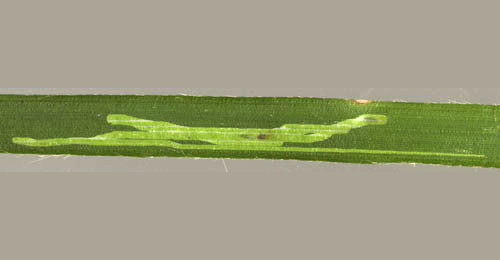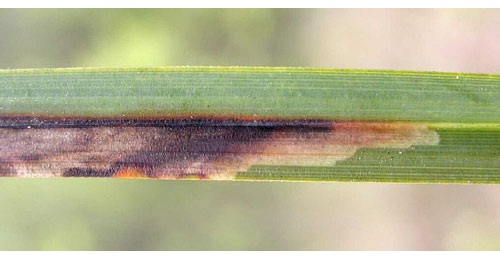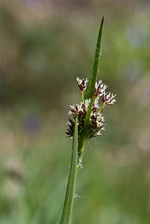|
||||||
|
LUZULA. Wood-rushes. [Juncaceae] |
|
|
Ten species of Luzula are recorded in Britain. These include the native Curved Wood-rush (L. arcuata), Field Wood-rush (L. campestris), Southern Wood-rush (L. forsteri), Heath Wood-rush (L. multiflora), Fen Wood-rush (L. pallidula), Hairy Wood-rush (L. pilosa), Spiked Wood-rush (L. spicata) and Great Wood-rush (L. sylvatica) and the introduced White Wood-rush (L. luzuloides) and Snow-white Wood-rush (L. nivea). The BSBI provide a downloadable plant crib for Luzula. Ten British miners are recorded on Luzula. A key to the European miners recorded on Luzula is provided in Bladmineerders van Europa. |
|
Key for the identification of the known mines of British |
Note: Diptera larvae may live in a corridor mine, a corridor-blotch mine, or a blotch mine, but never in a case, a rolled or folded leaf, a tentiform mine or sandwiched between two more or less circular leaf sections in later instars. Pupation never in a cocoon. All mining Diptera larvae are leg-less maggots without a head capsule (see examples). They never have thoracic or abdominal legs. They do not have chewing mouthparts, although they do have a characteristic cephalo-pharyngeal skeleton (see examples), usually visible internally through the body wall. The larvae lie on their sides within the mine and use their pick-like mouthparts to feed on plant tissue. In some corridor miners frass may lie in two rows on alternate sides of the mine. In order to vacate the mine the fully grown larva cuts an exit slit, which is usually semi-circular (see Liriomyza huidobrensis video). The pupa is formed within the hardened last larval skin or puparium and as a result sheaths enclosing head appendages, wings and legs are not visible externally (see examples). See Key to non-Diptera. |
1a > Leaf-miner: Larva forming irregular linear mine (Spencer, 1990: 345). Makes long upper surface galleries, which may double back on each other. The mines may extend to 20cms of leaf and show up as yellowish against the green leaf. They may also stain purple. The larvae pupate in the mine between late November and January (British leafminers) Rather narrow corridor, upper-surface or interparenchymatous, 12-20 cm in length, about 2 mm wide. Mines yellow, contrasting against the dark green leaves, but sometimes they are deep purple. The corridor changes direction at least twice. Generally it does not leave the blade. Frass in one or two large lumps. Pupation inside the mine. |
|
Chromatomyia luzulae (Hering, 1924) [Diptera: Agromyzidae]. |
1b > Leaf-miner: Long, rather narrow mine, upper surface or interparenchymal. The mine changes direction twice (upper to lower or vice versa). The mine frequently finishes in the leaf sheath. Frass in one or two large clumps. |
|
Cerodontha silvatica (Groschke, 1957) [Diptera: Agromyzidae]. |
1c > Leaf-miner: Long, rather narrow corridor, upper-surface or interparenchymatous mine. The mine changes direction one or two times. Often the corridor ends in the leaf sheath. Frass in one or two large lumps. Puparium in the lower part of the mine. Hibernation in the puparial state. |
|
Cerodontha bimaculata (Meigen, 1830) [Diptera: Agromyzidae]. |
1d > Leaf-miner: Larva forming irregular linear mine (Spencer, 1990: 345). Makes long upper surface galleries, which may double back on each other. The mines may extend to 20cms of leaf and show up as yellowish against the green leaf. They may also stain purple. The larvae pupate in the mine between late November and January (British leafminers) Rather narrow corridor, upper-surface or interparenchymatous, 12-20 cm in length, about 2 mm wide. Mines yellow, contrasting against the dark green leaves, but sometimes they are deep purple. The corridor changes direction at least twice. Generally it does not leave the blade. Frass in one or two large lumps. Pupation inside the mine. |
 Mine of Cerodontha luzulae on Luzula sylvatica Image: © Willem Ellis (Bladmineerders van Europa) |
|
Cerodontha luzulae (Groschke, 1957) [Diptera: Agromyzidae]. |
|
Key for the identification of the known mines of British |
Note: The larvae of mining Coleoptera, Hymenoptera and Lepidoptera may live in a corridor mine, a corridor-blotch mine, a blotch mine, a case, a rolled or folded leaf, a tentiform mine or sandwiched between two more or less circular leaf sections in later instars. Larva may pupate in a silk cocoon. The larva may have six legs (although they may be reduced or absent), a head capsule and chewing mouthparts with opposable mandibles (see video of a gracillarid larva feeding). Larvae of Hymenoptera and Lepidoptera usually also have abdominal legs (see examples). Frass, if present, never in two rows. Unless feeding externally from within a case the larva usually vacates the mine by chewing an exit hole. Pupa with visible head appendages, wings and legs which lie in sheaths (see examples). |
1a > Leaf-miner: The larva mines from the grass tip downwards and the mine occupies half or the whole of the leaf blade width. A whitish blotch is formed with characteristic narrow streaks of frass. Full depth blotch, slightly inflated, descending from the leaf tip, occupying half or the entire width of the blade. The larva may move and make a new mine elsewhere. In the latter case the mines are fairly short; otherwise an entire blade may be mined out. Frass in a some narrow greyish brown streaks. Pupation outside the mine. |
|
Elachista albifrontella (Hübner, 1817) [Lepidoptera: Elachistidae]. |
1b > Leaf-miner: Corridor widening while descending from the tip of the leaf. The mine is unusual because the sides are very irregularly scalloped out. Moreover, the mine is not evenly transparent, but rather yellowish green and motly, because the larva leaves patches of parenchyma uneaten, and does not feed full depth. Frass in a few irregular, interrupted length lines. Often 2-3 larvae in a mine. The larvae hibernate in the centre of the mine; after winter they leave their mine and pupate. |
|
Elachista apicipunctella Stainton, 1849 [Lepidoptera: Elachistidae]. |
1c > Leaf-miner: The larva starts mining near a leaf tip in early autumn. This early mine approximates to being linear but is very erratic in its course. In earl winter the the larva usually moves to anew leaf. This second mine usually takes the form of a compact but irregularly brownish blotch close to or often within the area of purplish discoloration of the dying leaf tip. Occasionally the larva does not change mines but extends the one made in autumn. Pupation takes place in a concealed place amongst debris or between closely applied leaves (Bland and Knill-Jones, 1988). Egg generally at the underside of the leaf tip. From September until the following spring a narrow meandering corridor is made. Then gradually the corridor widens to nearly the full width of the leaf. Generally the larvae make a new mine in early winter, obviously without the initial corridor. The mine in this stage is brown and situated close to (or within) the red coloured dying apical part of the leaf. Frass in large elongate dark spots. Pupation external. |
 Mine of Elachista gleichenella on Carex flacca Image: © Jean-Yves Baugnée (Bladmineerders van Europa) |
|
Elachista gleichenella (Fabricius, 1781) [Lepidoptera: Elachistidae]. |
1d > Leaf-miner: The mine formed is long, inflated and puckers the leaf surface. The larva often swaps leaves. Oviposition generally at the underside of the top half of the leaf. Between September and the end of February a very narrow mine is made, not longer than 3 cm, parallel to the midrib. The mine then suddenly widens to almost the full width of the leaf. The frass is concentrated in the transition area of the two mine types. In the broad part folds develop. Larvae can make a new mine, obviously without the initial part. Here the frass in concentrated around the entrance hole. Pupation outside the mine. |
|
Elachista regificella Sircom, 1849 [Lepidoptera: Elachistidae]. |
1e > Leaf-miner: A strongly contracted upper-surface tentiform mine, generally in the lower third of the leaf, beginning at the leaf base. Often a second or third mine is made, starting from the leaf tip. These secondary mines begin as a narrow, almost completely frass-filled corridor, that continues down to the leaf base.al the while widening into a tentiform mine. Pupation outside the mine (Steuer, 1980a). |
|
Elachista tengstromi Kalia, Bengstsson, Sulcs and Junnilainen, 2001 [Lepidoptera: Elachistidae]. |
1f > Leaf-miner: The mine in Luzula pilosa is rarely at the leaf-tip, being usually about halfway down the leaf blade and well clear of the winter/pring dieback. The autumn mine typically consists of a long stright slended gallery folloowing one of the veims. The mine is no wider than the larva and the frass is scattered towards or away from the leaf-tip. In spring the mine is contined as a broad elongated gallery with frass irregularly placed. Pupation occurs on the upper surface of a leaf and is anchored by a silk girdle (Bland and Knill-Jones, 1988). From autumn until early spring the larva makes a quite narrow corridor with a total length of 12-16 cm, essentually running parallel to the leaf venation; the corridor may change direction 2-3 times. Generally the corridor lies about halfway the length of the leaf. In March-April this gallery abruptly gives way to an elongate blotch, that generally obliterates the original gallery. The larva may leave its mine and restart elsewhere by making a lower-surface opening in a new leaf, not far from the leaf-tip. Pupation external. |
|
Elachista trapeziella Stainton, 1849 [Lepidoptera: Elachistidae]. |
| Last updated 05-Jul-2019 Brian Pitkin | ||

